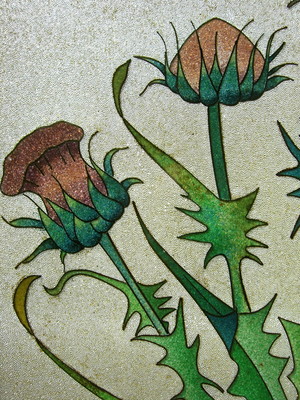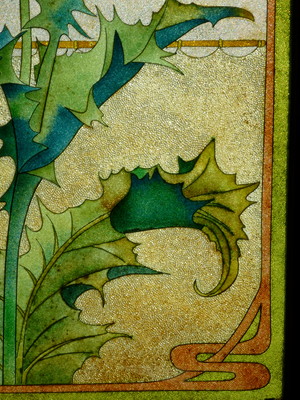'Thistle' Cloisonné window
'Thistle' Cloisonné Window
France, c.1905
Double-panelled cloisonné window
Each panel 177 x 44cm, incl. the wooden frame
Extraordinary rarity in good original condition
Dokumentation
On the internal face of both panels the stems and foliage of a cotton thistle with pink-coloured buds and flowers nestle against one another in a symmetrical vertical arrangement. In the background part of the way up a light curtain, like a veil, hangs from a horizontal brass bar. The green leaves exhibit a rich palette of colours. Overall this is an artless composition, surrounded by a simple classic art nouveau frame in light green, set off on the inside by an edging in antique pink that is entwined with the green in the outer corners of the panels. In the upper part grow two symmetrically placed thistle stems, each with two flowers in bloom from which yellow stamens sprout, which together form an airy, floral round-headed arch over the prickly, tall-growing plant below. The coloured glass pearls, granules and globules sparkle in a particularly brilliant manner when the sun shines through the composition.
This is not a stained-glass window in the traditional sense of the term: although it is translucent, it was produced using a completely different technique, which was invented at the end of the 19th c. In 1894 it was signed in by the Parisian painter Amédée Navarein in London, and registered three years later by two men, the manufacturer Theophil Pfister and the businessman Emil Barthels, founders of The London Cloisonné Glass Company; until then, the cloisonné technique had only been heard of in relation to enamelwork.
We are dealing therefore with a layer of glass particles ground to different degrees of delicacy that have been sandwiched between two panes of glass, with coloured glass particles divided into areas by brass strips according to the design and bound together with fish glue.
The Thistle window of cloisonné glass is one of the few extant examples – as well as being a most aesthetically pleasing and exceptionally well-preserved one. An attribution to the School of Nancy (L'École de Nancy) cannot be established with certainty, but the thistle, which appears also in the coat of arms of the city, makes it likely. The cotton thistle of Nancy is a symbol of resistance during the annexation of Alsace-Lorraine by the Germans in 1871. It was also a symbol of deep grief over the loss of the district - until the reunification with France in 1918.
There is one more French piece existing in the current exhibition at the Lis Museum House in Salamanca.





